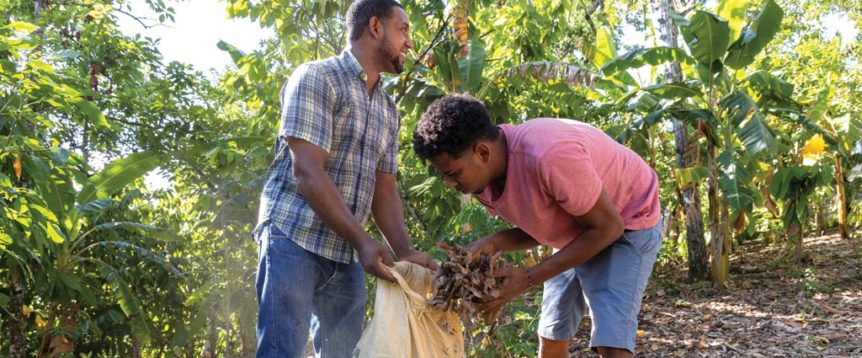Meet: Chano, Bian & Dario
Cacao farmers, Dominican Republic
Not all crops beloved in the United States can be grown here. In fact, cacao (think chocolate) and coffee are imported. And not unlike farmers in the U.S., the men and women who grow these crops face the effects of climate change.
“Climate change is our biggest challenge. It destabilizes our harvest. It drops our productivity, so our economies also get destabilized,” says Jesus Maria Arias, who goes by Chano. The 38-year-old grew up in a family of farmers and has been farming on his own for more than 20 years, growing cacao and other fruit trees. Cacao, he says, is an important crop where he lives. “Since I was a boy, I’ve known cacao as the main source of income for this community and this region.”
But like any other crop, cacao relies on the weather, and climate change has made it hard for farmers in Chano’s region to be economically stable. “With climate change, every other year there’s a ‘bad’ year [low harvest]. That means that we have unsustainable economies,” he says.
Although many farmers in the Dominican Republic grow their cacao organically, 35-year-old Santo Cruz, who goes by Bian, says there’s a lot they can still stand to learn. Clif Bar has been helping them with that. The cacao grown in the Altamira municipality goes exclusively to Clif Bar. In turn, the company has partnered with the Dominican government, agronomists and farmers to implement the Living Income Project, which aims to close the living-income gap for cacao farmers. Clif Bar has helped farmers to diversify their crops and implement organic agroforestry systems to stabilize crops and bring in more income.
“Organic farming is common for cacao farmers in this country. But many of the practices connected to organic farming—most people don’t do them,” Bian explains. “Before, we would let nature do its own thing. Now thanks to the project, we make our own compost. We’ve realized plants need food, and we need to feed them so that they can produce better. We’ve learned to properly prune in order to have a better harvest. Now, I trust myself better in the management of my farm.”
The farmers have also learned techniques like mulching or how to use hedgerows, a common agroforestry practice to plant trees or shrubs alongside crops or around pastureland to increase biodiversity and reduce erosion.
“We have worked with organic farming for over a decade, protecting our crops from chemicals or external sources of contamination. Thanks to this project, we are becoming pioneers in creating optimized agroforestry systems that provide different crops for subsistence, as well as for additional income,” Chano says.
The ultimate intent of the project is to help these small-shareholder farmers improve their situation, with the hope of moving beyond poverty. “A smallholder goes through a lot of struggle,” says 50-year-old Zacarias Polanco, who goes by Dario. “The little we make is not enough for us to cover our personal and family expenses, to raise our children. When you don’t have a living income, you can’t properly feed your children, which is the most important thing in life.”
With more income, farmers could buy more land and increase their cacao production, which is a huge step toward getting out of poverty.
“The income we are currently getting from cacao is not enough. It doesn’t allow us to think about the future; it just allows us to cover our basic needs [and sometimes not even],” Chano says. But with the help of Clif Bar, Chano now allows himself to dream a little and think about what the future could hold. A living income, he says, “would mean family and personal stability. I wouldn’t have to worry about the future, because I can have an income that allows me to save. Saving would allow me to grow my farm, and I could improve my situation as a farmer.

